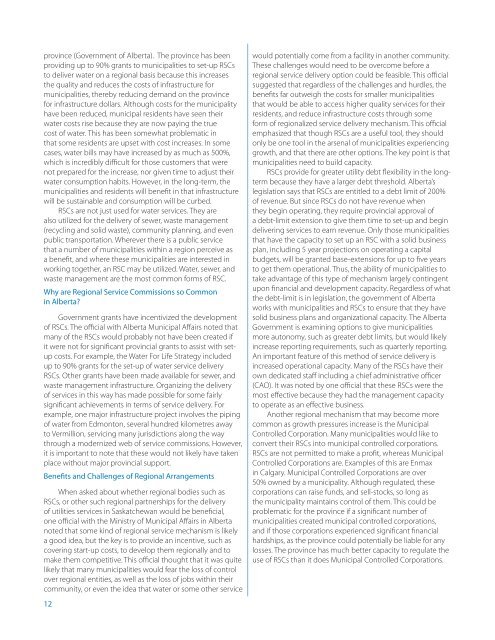Long-term Debt Limits in Saskatchewan - Nipawin
Long-term Debt Limits in Saskatchewan - Nipawin
Long-term Debt Limits in Saskatchewan - Nipawin
You also want an ePaper? Increase the reach of your titles
YUMPU automatically turns print PDFs into web optimized ePapers that Google loves.
prov<strong>in</strong>ce (Government of Alberta). The prov<strong>in</strong>ce has been<br />
provid<strong>in</strong>g up to 90% grants to municipalities to set-up RSCs<br />
to deliver water on a regional basis because this <strong>in</strong>creases<br />
the quality and reduces the costs of <strong>in</strong>frastructure for<br />
municipalities, thereby reduc<strong>in</strong>g demand on the prov<strong>in</strong>ce<br />
for <strong>in</strong>frastructure dollars. Although costs for the municipality<br />
have been reduced, municipal residents have seen their<br />
water costs rise because they are now pay<strong>in</strong>g the true<br />
cost of water. This has been somewhat problematic <strong>in</strong><br />
that some residents are upset with cost <strong>in</strong>creases. In some<br />
cases, water bills may have <strong>in</strong>creased by as much as 500%,<br />
which is <strong>in</strong>credibly difficult for those customers that were<br />
not prepared for the <strong>in</strong>crease, nor given time to adjust their<br />
water consumption habits. However, <strong>in</strong> the long-<strong>term</strong>, the<br />
municipalities and residents will benefit <strong>in</strong> that <strong>in</strong>frastructure<br />
will be susta<strong>in</strong>able and consumption will be curbed.<br />
RSCs are not just used for water services. They are<br />
also utilized for the delivery of sewer, waste management<br />
(recycl<strong>in</strong>g and solid waste), community plann<strong>in</strong>g, and even<br />
public transportation. Wherever there is a public service<br />
that a number of municipalities with<strong>in</strong> a region perceive as<br />
a benefit, and where these municipalities are <strong>in</strong>terested <strong>in</strong><br />
work<strong>in</strong>g together, an RSC may be utilized. Water, sewer, and<br />
waste management are the most common forms of RSC.<br />
Why are Regional Service Commissions so Common<br />
<strong>in</strong> Alberta?<br />
Government grants have <strong>in</strong>centivized the development<br />
of RSCs. The official with Alberta Municipal Affairs noted that<br />
many of the RSCs would probably not have been created if<br />
it were not for significant prov<strong>in</strong>cial grants to assist with setup<br />
costs. For example, the Water For Life Strategy <strong>in</strong>cluded<br />
up to 90% grants for the set-up of water service delivery<br />
RSCs. Other grants have been made available for sewer, and<br />
waste management <strong>in</strong>frastructure. Organiz<strong>in</strong>g the delivery<br />
of services <strong>in</strong> this way has made possible for some fairly<br />
significant achievements <strong>in</strong> <strong>term</strong>s of service delivery. For<br />
example, one major <strong>in</strong>frastructure project <strong>in</strong>volves the pip<strong>in</strong>g<br />
of water from Edmonton, several hundred kilometres away<br />
to Vermillion, servic<strong>in</strong>g many jurisdictions along the way<br />
through a modernized web of service commissions. However,<br />
it is important to note that these would not likely have taken<br />
place without major prov<strong>in</strong>cial support.<br />
Benefits and Challenges of Regional Arrangements<br />
When asked about whether regional bodies such as<br />
RSCs, or other such regional partnerships for the delivery<br />
of utilities services <strong>in</strong> <strong>Saskatchewan</strong> would be beneficial,<br />
one official with the M<strong>in</strong>istry of Municipal Affairs <strong>in</strong> Alberta<br />
noted that some k<strong>in</strong>d of regional service mechanism is likely<br />
a good idea, but the key is to provide an <strong>in</strong>centive, such as<br />
cover<strong>in</strong>g start-up costs, to develop them regionally and to<br />
make them competitive. This official thought that it was quite<br />
likely that many municipalities would fear the loss of control<br />
over regional entities, as well as the loss of jobs with<strong>in</strong> their<br />
community, or even the idea that water or some other service<br />
12<br />
would potentially come from a facility <strong>in</strong> another community.<br />
These challenges would need to be overcome before a<br />
regional service delivery option could be feasible. This official<br />
suggested that regardless of the challenges and hurdles, the<br />
benefits far outweigh the costs for smaller municipalities<br />
that would be able to access higher quality services for their<br />
residents, and reduce <strong>in</strong>frastructure costs through some<br />
form of regionalized service delivery mechanism. This official<br />
emphasized that though RSCs are a useful tool, they should<br />
only be one tool <strong>in</strong> the arsenal of municipalities experienc<strong>in</strong>g<br />
growth, and that there are other options. The key po<strong>in</strong>t is that<br />
municipalities need to build capacity.<br />
RSCs provide for greater utility debt flexibility <strong>in</strong> the long<strong>term</strong><br />
because they have a larger debt threshold. Alberta’s<br />
legislation says that RSCs are entitled to a debt limit of 200%<br />
of revenue. But s<strong>in</strong>ce RSCs do not have revenue when<br />
they beg<strong>in</strong> operat<strong>in</strong>g, they require prov<strong>in</strong>cial approval of<br />
a debt-limit extension to give them time to set-up and beg<strong>in</strong><br />
deliver<strong>in</strong>g services to earn revenue. Only those municipalities<br />
that have the capacity to set up an RSC with a solid bus<strong>in</strong>ess<br />
plan, <strong>in</strong>clud<strong>in</strong>g 5 year projections on operat<strong>in</strong>g a capital<br />
budgets, will be granted base-extensions for up to five years<br />
to get them operational. Thus, the ability of municipalities to<br />
take advantage of this type of mechanism largely cont<strong>in</strong>gent<br />
upon f<strong>in</strong>ancial and development capacity. Regardless of what<br />
the debt-limit is <strong>in</strong> legislation, the government of Alberta<br />
works with municipalities and RSCs to ensure that they have<br />
solid bus<strong>in</strong>ess plans and organizational capacity. The Alberta<br />
Government is exam<strong>in</strong><strong>in</strong>g options to give municipalities<br />
more autonomy, such as greater debt limits, but would likely<br />
<strong>in</strong>crease report<strong>in</strong>g requirements, such as quarterly report<strong>in</strong>g.<br />
An important feature of this method of service delivery is<br />
<strong>in</strong>creased operational capacity. Many of the RSCs have their<br />
own dedicated staff <strong>in</strong>clud<strong>in</strong>g a chief adm<strong>in</strong>istrative officer<br />
(CAO). It was noted by one official that these RSCs were the<br />
most effective because they had the management capacity<br />
to operate as an effective bus<strong>in</strong>ess.<br />
Another regional mechanism that may become more<br />
common as growth pressures <strong>in</strong>crease is the Municipal<br />
Controlled Corporation. Many municipalities would like to<br />
convert their RSCs <strong>in</strong>to municipal controlled corporations.<br />
RSCs are not permitted to make a profit, whereas Municipal<br />
Controlled Corporations are. Examples of this are Enmax<br />
<strong>in</strong> Calgary. Municipal Controlled Corporations are over<br />
50% owned by a municipality. Although regulated, these<br />
corporations can raise funds, and sell-stocks, so long as<br />
the municipality ma<strong>in</strong>ta<strong>in</strong>s control of them. This could be<br />
problematic for the prov<strong>in</strong>ce if a significant number of<br />
municipalities created municipal controlled corporations,<br />
and if those corporations experienced significant f<strong>in</strong>ancial<br />
hardships, as the prov<strong>in</strong>ce could potentially be liable for any<br />
losses. The prov<strong>in</strong>ce has much better capacity to regulate the<br />
use of RSCs than it does Municipal Controlled Corporations.






